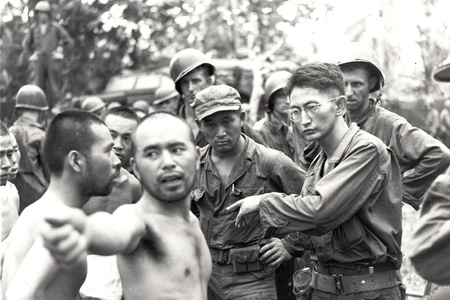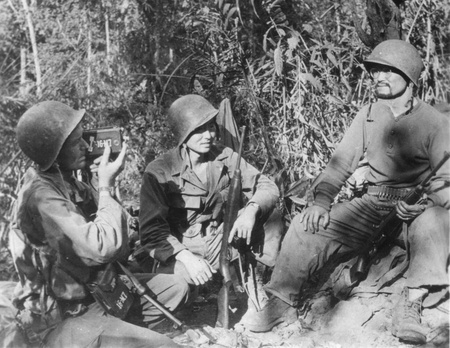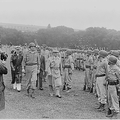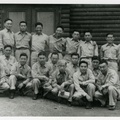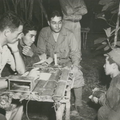Nisei soldiers in the Military Intelligence Service (MIS) served in the Asia Pacific war zone as interrogators of Japanese prisoners of war, they entered caves to persuade Japanese soldiers to surrender, they were in the Special Forces working behind enemy lines, and they were in the first or second wave of the Marines or infantry invasion forces. All these duties brought the Nisei in close proximity to Japanese soldiers alive and dead. Many of these Nisei had siblings who were going to school in Japan and served in the Japanese military. MIS Nisei said they could mentally handle every situation that combat produced but would be challenged if they met a sibling in enemy uniform, face to face when entering a cave or while working behind enemy lines, or to see a sibling dead. It is difficult to estimate the Nisei’s mental anguish in these situations and accounts have not been found in the National Archives or in books. The four cases cited below describe siblings fighting for America and for Japan.
Akune brothers
Harry and Ken Akune served in the MIS and their two brothers, Saburo and Shiro, were drafted into the Imperial Japanese Navy. After the death of his wife, Ichiro—father of the Akune boys—took his nine children to settle in his hometown in Kagoshima Prefecture. Later, before WW II, Harry and Ken were sent to California to work and send remittances to their family.
Following Japan’s attack of Pearl Harbor, Harry and Ken Akune were among the 118,000 persons of Japanese ancestry who were placed in internment camps against their will. “Then, one day an Army recruiter came with news that the government now wanted young men from the internment camps to join the military. I didn't care what the government had done to us," Ken Akune said.
"When they came around, it was a chance for me to do what Americans were supposed to do, go out and serve their country. When they opened their door, for me, I felt like my rights were given back to me. I also thought about if I met my brother out in the field, what would I do?" Ken Akune said. "You don't want to kill him, but if he points his rifle at you, what can you do?"
Ken and Harry graduated from the MIS Language School in 1942 and were deployed to the Asia Pacific war zone, Ken to Burma to work for the Office of War Information to conduct propaganda against Japan. Harry was sent to New Guinea and the Philippines to interrogate Japanese prisoners and to translate documents. Harry, who had not made a parachute jump before, joined his colleagues of the 503rd Paratroopers to jump onto Corregidor island. Their brothers in the Japanese Navy, Saburo was a spotter of American targets for the kamikaze pilots and Shiro, just 15, served in the training program for recruits at the Sasebo Naval Base.
After the war, Harry and Ken, while serving in the demobilization of Japanese armed forces, visited their family in Kagoshima Prefecture. The four brothers, two on each side, got into a heated argument as to which side, Japan or America, was right. The confrontation was stopped by their father, who reminded them the war was over.
Saburo and Shiro returned to live in America, where, ironically, Shiro was drafted and fought in the Korean War.
Yempuku Brothers
Lieutenant Ralph Yempuku served as Commander of the 2nd Battalion of Detachment 101, Office of Strategic Services (OSS) in Burma, and subsequently in Detachment 202 in Kunming, China. Three of his brothers served in the Imperial Japanese Army.
Yempuku and 17 other Nisei of the 442nd Combat Team were selected to serve as linguists in the OSS. Yempuku’s unit in Burma consisted of Americans, British and several thousand Kachin natives of northern Burma. A Kachin served as Yempuku’s body guard and interpreter and their language of communication, ironically, was Japanese. When Detachment 101 disbanded on July 12, 1945, Yempuku joined OSS Detachment 202 in Kunming, China.
Yempuku had frequently thought of his brothers in Japan. On September 12, 1945 Yempuku was in the Peninsula Hotel in Hong Kong where he came close to meeting his brother Donald.
Donald, an interpreter for the Japanese Army, walked into the hotel with the Japanese surrender delegation. Donald later told a Nisei interrogator that seeing Ralph in “enemy uniform was the most trying moment in my life. For a brief second I felt the urge to call out but I could not allow myself to do that. I just couldn’t. In my mind the war was still going on and we were enemies.”
The data does not show that Ralph remained for the surrender ceremonies. Following the War, fearing that his family had perished from the atom bomb, Ralph visited Ataka Island near Hiroshima City. He found his mother and father alive and well as all his brothers, Paul, Goro, Donald, Joshu, and Toru. Toru, Goro, and Donald served in the Japanese Army.
Yempuku, who retired as a Colonel in the Army Reserves, received the Combat Infantryman’s Badge, Soldier’s Medal, and the Bronze Star with oak leaf cluster.
Fukuhara brothers
Lieutenant Harry Fukuhara, USAR (Ret) served as an interrogator and translator in New Guinea and the Philippines and subsequently served in the Occupation and Post-Occupation period of Japan. His two brothers were assigned to an Army suicide unit for the defense of Kyushu Island.
When Fukuhara’s father died in 1933, his mother decided to move the family back to Hiroshima, Japan. There, Harry attended school with his siblings. At age 18, Fukuhara moved back to America. His three brothers decided to remain in Japan. When war broke out Fukuhara was interned at the Gila River, Arizona internment center. Despite his detention for no reason other than his ethnicity, Fukuhara said "I realized the time had come for me to decide whether I wanted to be 100% American and fight for my country.”
Fukuhara enlisted in November 1942, attended the MIS Language School and was deployed to New Guinea. On August 10, 1945, Fukuhara received a battlefield commission to Second Lieutenant. While in the Philippines, Fukuhara’s unit was preparing for the invasion of Kyushu. This did not occur because the atom bomb was dropped over Hiroshima and Nagasaki and, shortly after that, Japan surrendered.
Early in his assignment in Japan, he was able to return to Hiroshima where he found his mother and her sister safe, his older brother survived but soon died as the result of radiation. His two other brothers were in the Japanese Army training for the allied invasion of Kyushu. If the atom bomb did not intervene, Fukuhara (for the U.S.) and his two brothers, Pierce and Frank (for Japan), might have fought against each other in the same battle.
Fukuhara remained in the Army and retired as a full colonel in 1971 and subsequently served as an Army civilian in Japan for another 20 years. Fukuhara received the Combat Infantryman’s Badge, Bronze Star Medal with two oak leaf clusters, a high decoration from the Emperor of Japan, the Intelligence Medal of Merit from the Central Intelligence Agency and induction into the MIS Hall of Fame.
Matsumoto brothers
M/Sgt Roy H. Matsumoto served with the 5307th Composite Unit (Provisional), known as the Merrill’s Marauders, a special forces unit in Burma during WW II. Roy’s brother, Tsutomu Tom Matsumoto, a MIS linguist, served in the Occupation of Japan and retired as a Colonel. Roy’s other two brothers, Isao and Noboru, served in the Japanese military, Noboru in the artillery in Guadalcanal and Hiroshi in China. Roy’s third brother in Japan worked as a civilian for the Imperial Japanese Navy.
Born in Laguna Beach, California and at age 8, Roy was taken to Hiroshima, Japan to live with his grandparents for 9 years. After graduating from high school he returned to California. Meanwhile, his mother and her six other children had gone to Japan to live. When war broke out in 1941, Roy was sent to the Jerome, Arkansas internment camp and in 1942 he volunteered to join the MIS.
Following his graduation at MIS Language School, Roy joined the Merrill’s Marauders, where he performed heroically. Hiking in the Burmese jungle he discovered an enemy telephone line, obtained equipment to tap it, and the results were used to bomb enemy targets. Also, on the night of April 5, 1944 at Nhpun Ga Hill he crawled to the enemy bivoac area, eavesdropped on enemy’s plans for the following morning and reported his findings to his battalion commander. The information was used to re-arrange the battalion’s defense line. When the enemy attacked the following morning in overwhelming numbers, they were ambushed resulting in 53 dead. Matsumoto saved his battalion from probable annihilation.
He was subsequently assigned to China where he met his brother, Hiroshi, and a cousin in a prisoner of war camp in Shanghai. Subsequently, while serving in the Occupation of Japan, Matsumoto visited Hiroshima where he found his mother and siblings had survived the atomic bomb. The Merrill’s Marauders has the distinction of being the first American unit to fight on the Asian continent since the Boxer Rebellion.
Matsumoto was awarded the Legion of Merit, 5 bronze star medals, Combat Infantryman’s Badge, and was inducted into the Ranger Hall of Fame and the MIS Hall of Fame.
* This article was originally published in JAVA Advocate in Summer 2015 Volume XXIII - Issue II.
© 2015 JAVA Advocate



